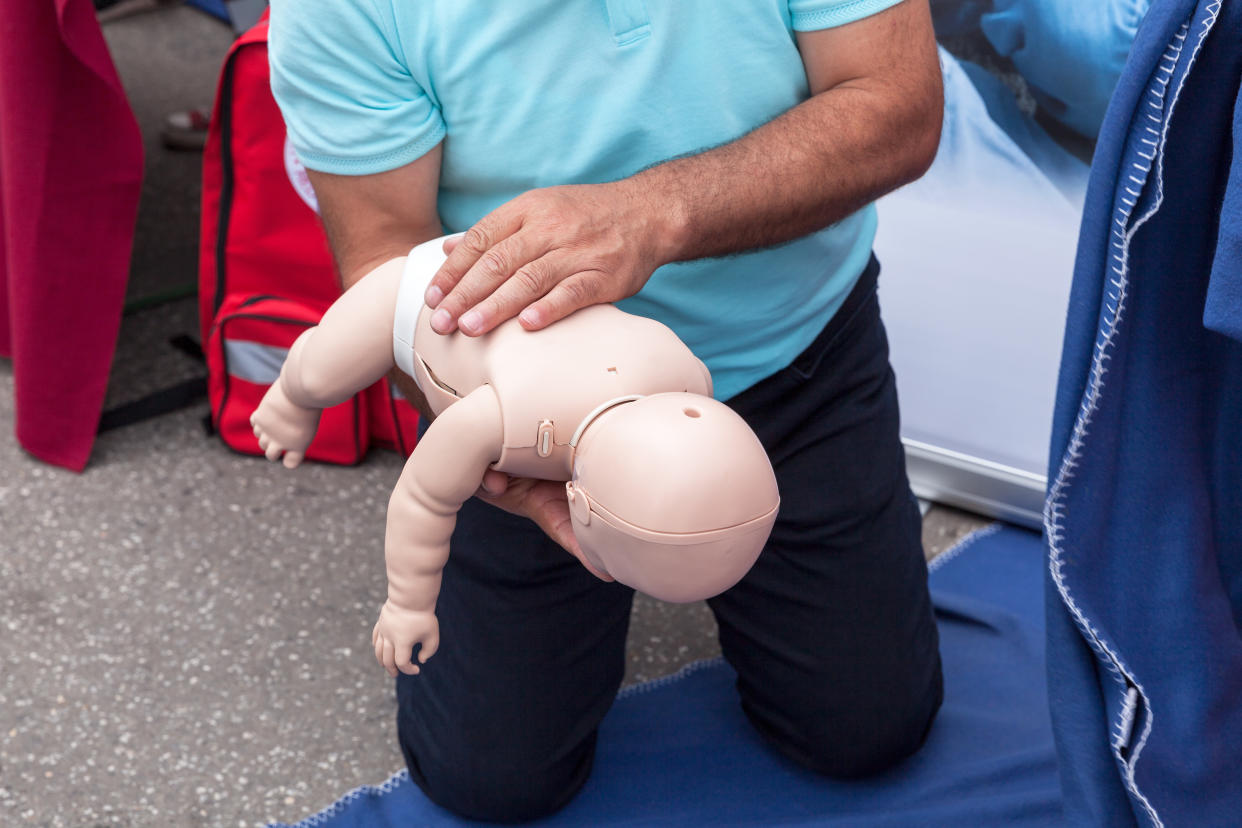What should you do if a baby, child or adult is choking? Here’s what experts recommend.

There’s a good possibility you will witness someone choking at some point in your life: Choking is the fourth-leading cause of unintentional injury death, according to the National Safety Council.
You’ve been warned about the risk of choking since you were young, but would you actually know what to do if someone around you were choking? If not, it’s crucial to learn, experts say. "With choking, there’s an obstruction in a person’s airway and failure to act will unfortunately lead to eventual suffocation and asphyxiation," Dr. Eric Adkins, an emergency medicine physician at the Ohio State University Wexner Medical Center, tells Yahoo Life.
It’s also essential to act fast, Dr. Danelle Fisher, chair of pediatrics at Providence Saint John’s Health Center in Santa Monica, Calif., tells Yahoo Life. “Sometimes you have minutes or even seconds to reestablish that airway before permanent damage is done,” she says. “It’s a scary situation that needs an immediate response.”
Many organizations, including the Red Cross, offer courses on what to do if someone is choking. But if you don’t have time to take a course or just know you’ll never get around to it, it’s important to at least have some basic knowledge of what to do in an emergency. Here's what experts recommend.
First, who is most likely to choke?
“Choking can happen to anyone,” says Dr. Zeeshan Khan, associate professor at the Rutgers Robert Wood Johnson Medical School, but added that kids under 5 and older adults are at the highest risk.
Children under 4 in particular are more prone to choking “because they have smaller airways to begin with, and they’re not used to handling different textures of food,” Fisher says. They’re also “impulsive about what they put in their mouth,” she adds.
With older adults, “the swallowing function can change, making people more prone to choking,” Adkins says.
Common causes of choking
Choking can happen in a range of situations, but experts say that the main causes in children are food, coins, toys and balloons.
In adults, “the most common causes of choking almost always involves food,” Khan says. However, he adds, “the elderly may have problems with chewing and swallowing that can lead to choking.”
What to do if a baby is choking
If anyone else is there, Fisher recommends asking them to call 911 while you take action. And, if you’re alone, try to dislodge the food first. “Your first attempt will be more lifesaving than calling 911 first,” she says.
If a child is under the age of 1, you’ll want to hold the baby face down and do back blows, Fisher says. “That means taking the heel of your hand and aiming between the shoulder blades,” she says. This creates a strong vibration and pressure in the airway, which can usually dislodge the object, she says.
The British Red Cross specifically recommends that you give up to five back blows while holding the baby face-down along your thigh with their head lower than their butt and supporting their head. If the back blows don’t help, turn the baby over so that they are facing up, place two fingers in the middle of their chest just below the nipples, and push downward sharply up to five times. This squeezes air out of the baby’s lungs and may help dislodge the blockage, according to the British Red Cross.

What to do if a child is choking
The American Academy of Pediatrics recommends using the Heimlich maneuver on children who are choking. Again, ask someone to call 911 if they are available, while you take action. You can do this when the child is lying down, sitting or standing.
If they are sitting or standing, position yourself behind them and wrap your arms around their waist, the AAP says. Place the thumb side of your fist in the middle of their abdomen, grab that fist with your free hand and press inward with rapid, upward thrusts. Repeat these thrusts until the object is coughed up or the child starts to breathe or cough.
If the child is unconscious, you'll want to do what's called a tongue-jaw lift. To do this, the AAP says to open their mouth with your thumb held over their tongue and your fingers wrapped around the lower jaw (this draws the tongue away from the back of the throat). You may be able to clear the airway this way. If you can see what’s causing the blockage, try to remove it with a sideways sweep of your finger — just be careful, since this could push the object down even farther.
If the child hasn’t started breathing again, tilt their head back gently and lift their chin, the AAP says. Then, place your own mouth over their mouth, pinch their nose shut and give two breaths lasting one-and-a-half to two seconds. Then, return to the Heimlich maneuver. Keep repeating the steps until the child starts breathing again or help arrives.
What to do if an adult is choking
For adults, it’s important to first ask if they’re choking, Adkins says. If they indicate that they are, you’ll take similar steps to those you’d do for a child, according to the American Red Cross. Give them five back blows, followed by five abdominal thrusts, if the blows didn’t dislodge the object.
Keep repeating this cycle or call 911 if you can’t dislodge the object.
After the choking episode is resolved, it’s a good idea to see a doctor, Khan says. “There may be complications from the episode,” he says.
Wellness, parenting, body image and more: Get to know the who behind the hoo with Yahoo Life's newsletter. Sign up here.
